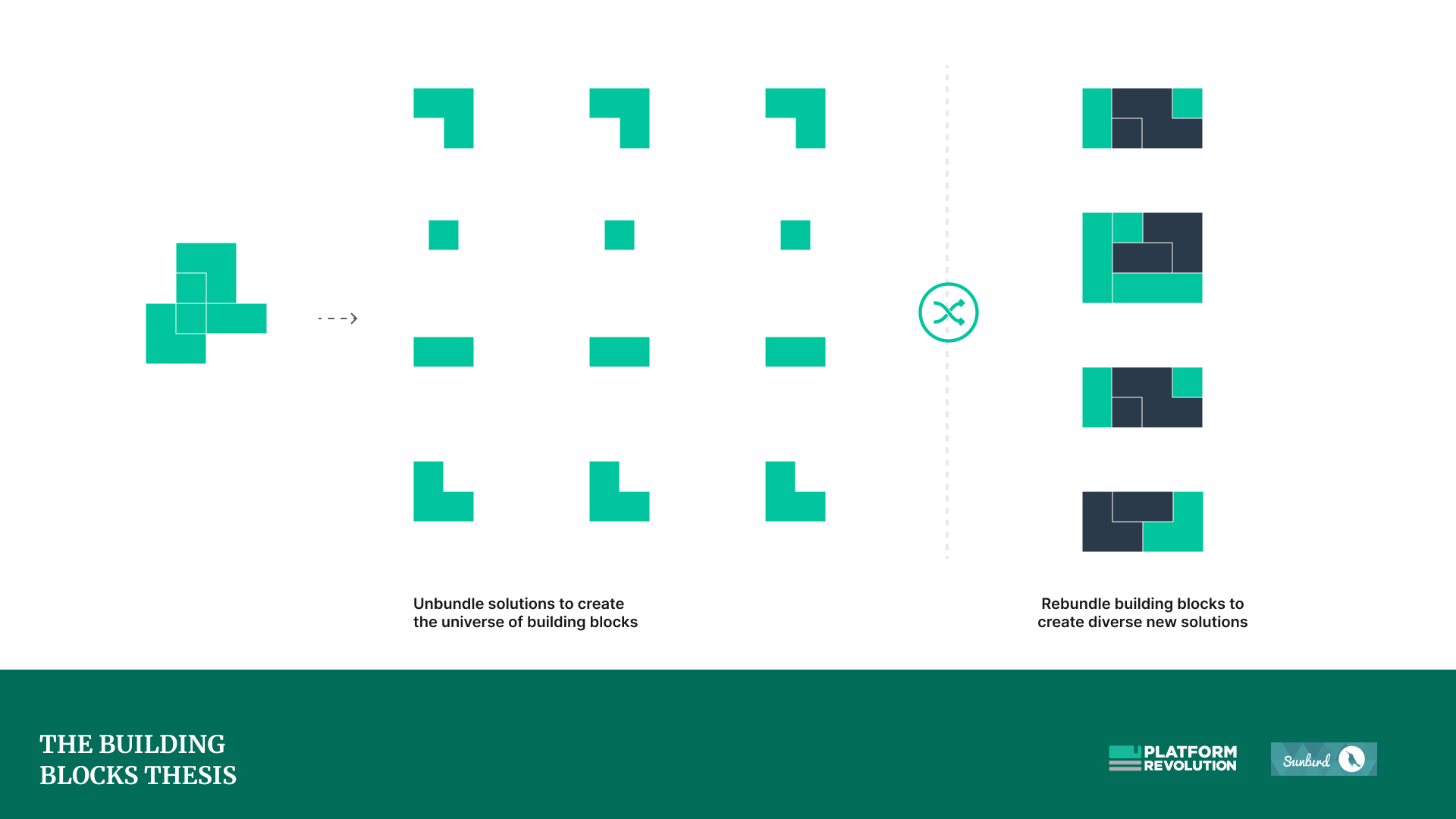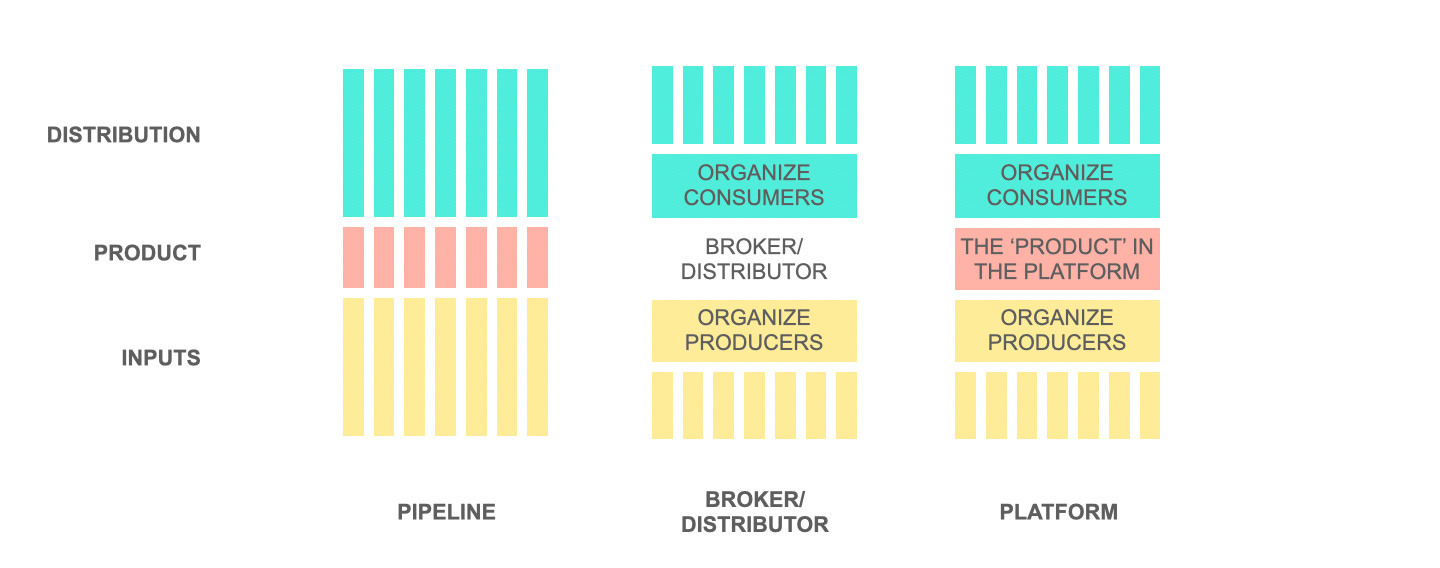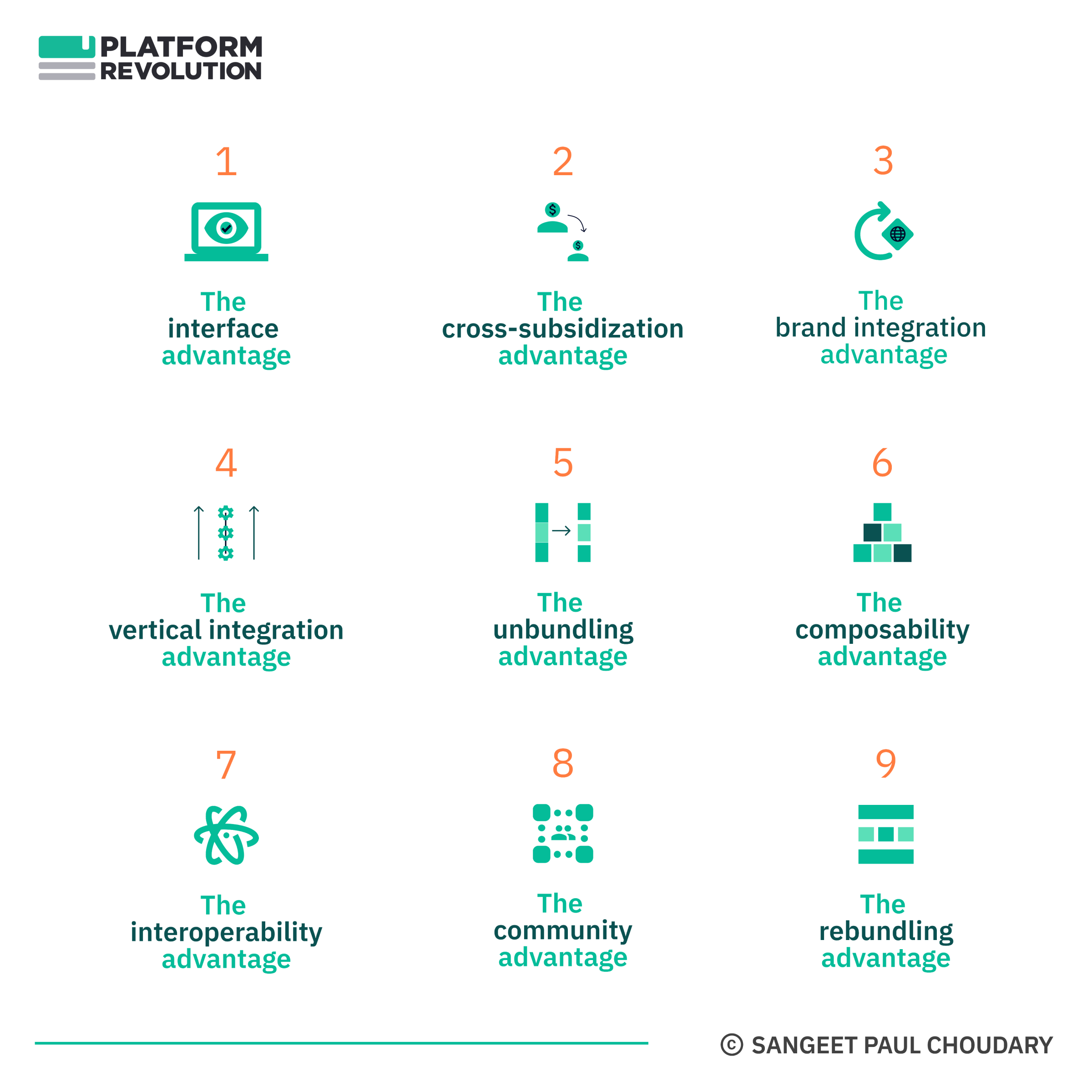Strategy
The Building Blocks Thesis – Volume 1
Building Blocks Thesis: A New Way to Organize Ecosystem Interactions
Platforms are, essentially, new organizing mechanisms to organize ecosystem interactions.
Over the past decade, we’ve seen a certain format of organization – aggregation of market activity e.g. through marketplaces, social networks etc – as the dominant mechanism of organization in the platform economy.
All that is about to change!
We’re already seeing a shift towards an alternate organizing mechanism with the rise of Web3. Over the past several years, multiple efforts to set up public digital infrastructures and national digital stacks have further demonstrated alternate models of organization.
We’re on the cusp of a shift!
But this shift is larger than merely a shift from private to public, or a shift from closed to open, or a shift from centralized to decentralized, or a shift from Web2 to Web3.
We believe there’s a much larger thesis to this shift. We call it the Building Blocks Thesis.
This essay is the first in a three-part volume explaining the core ideas underpinning the Building Blocks thesis (Fully illustrated deep-dive launching on May 24, 2022).
Let’s get started!
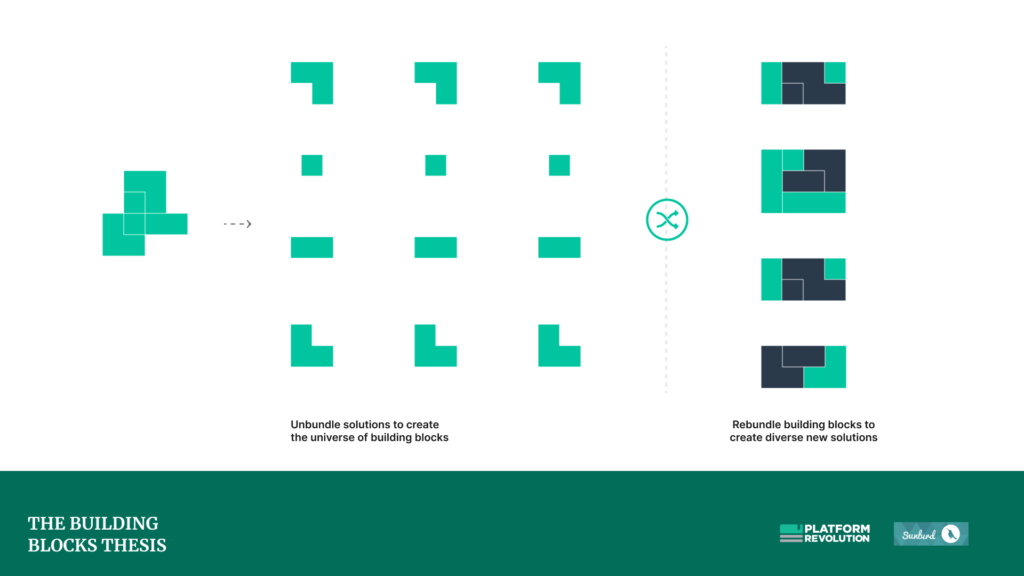
The rise of the platform economy
Over the course of the past two decades, three simultaneous forces have ushered in a new era of scale.
First, global connectivity – enabled by mobile penetration and social technologies – have driven the creation of a global network of connected producers and consumers, allowing businesses to create new markets of value exchange.
Second, the adoption of the cloud as a global ‘compute’ infrastructure enables process interoperability across the value chain (e.g. through API-based connectivity) and provides the ability to leverage external innovation by allowing third parties to innovate on a company’s resources.
Finally, the explosion of data production, spurred by global adoption of social technologies and sensors, combined with improvements in our ability to process and interpret data, enable businesses to serve markets at scale while informing all market participants and making market interactions more efficient.
Today, these three forces – collectively powering the platform economy – enable businesses to leverage open innovation and aggregate markets of exchange.
Components vs complements
The platform economy has fundamentally transformed value creation.
Through most of the twentieth century, businesses scaled through vertical integration, integrating multiple activities across supply, production, and distribution.
With growing connectivity, cloud adoption, and data production, firms can now leverage resources outside their organizational boundaries to create and deliver solutions. Openness allows firms to scale both solution creation and usage.
There are two ways to architect open business models.
- Openness in solution design: First, openness in solution design, by allowing a larger ecosystem to create solution components, has led to the rise of open innovation, best exemplified in the rise of open source communities like Linux and crowdsourcing initiatives like Innocentive. These solution components, created in an open ecosystem, are then bundled into a solution provided by the firm. For instance, a software business leveraging open source software leverages open solution components to create and sell proprietary products.
- Openness in solution usage: Second, openness in solution usage allows a larger ecosystem to create complements that drive solution usage, and has led to the rise of market aggregation platforms, which aggregate demand at scale and attract providers of solution complements to serve this demand. For instance, listings on Etsy and photos on Instagram are examples of complements that make the underlying platform more attractive.
This difference between solution components and solution complements is critical. Solution components are utilized by the solution creator to build the solution. Solution complements are used in conjunction with the solution by the end user, making the solution more attractive.
For instance, Amazon’s shopping cart functionality is a solution component to its marketplace while listings from third party vendors are complements that make the marketplace more attractive for use.
As a result of openness, firms no longer create value just through vertical integration. Increasingly, firms leverage the power of open innovation and market aggregation to create value through open business models.
This shift has played out over the course of the past three decades. First, the rise of open source software, and subsequently, crowdsourcing through the web enabled firms to leverage open innovation. Next, near-zero marginal costs of serving users (powered by the internet) enabled firms (starting with the BigTech, but increasingly all consumer businesses) to leverage market aggregation. Third, digitization across the value chain and adoption of APIs further accelerated this shift across both production and consumption.
This shift is shown in the diagram below.
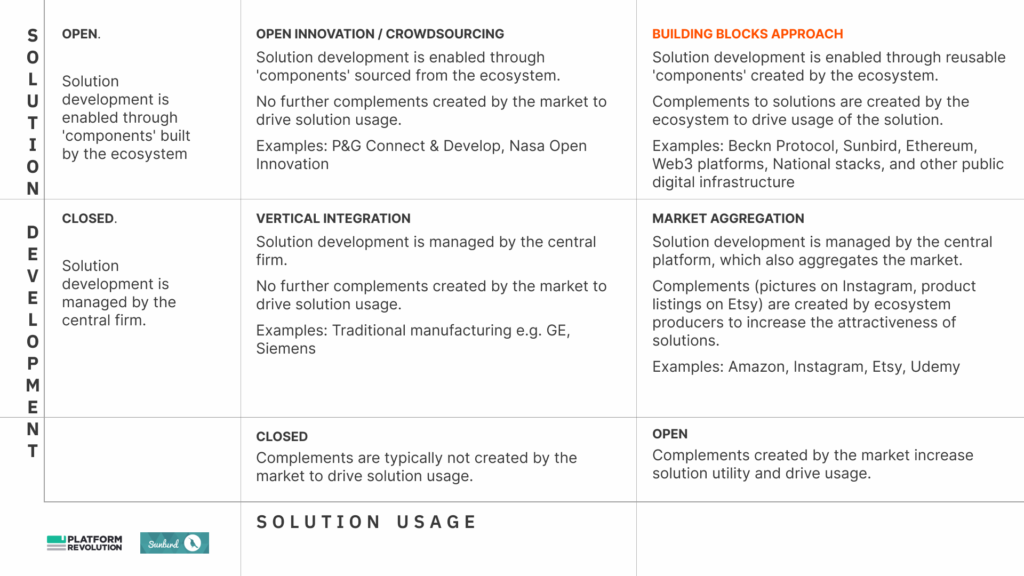
Today’s open business models have limitations, as described in the preceding section. In particular, large scale societal problems - in domains as diverse as primary education, healthcare, energy, and micro finance - cannot be adequately solved through standardization of solution development and/or solution usage
Feel Free to Share
Download
Our Insights Pack!
- Get more insights into how companies apply platform strategies
- Get early access to implementation criteria
- Get the latest on macro trends and practical frameworks
Limitations of open business models today
Openness enables a business to leverage ecosystem innovation, both in solution development and solution usage. However, both open innovation and market aggregation are limited in their effectiveness at driving solutioning across a diverse scope of use cases.
Open innovation leverages ecosystem agency in solution development but it also presents a bottleneck in solution usage. Usage of solution is limited to the use cases defined by the firm developing the solution.
Consider a software company leveraging open source software. By using open source, its solution development leverages the power of the open source community. However, the end solution usage (use case for the end solution) is narrowly defined by the company and cannot scale across diverse use cases and usage contexts. Hence, while open innovation leverages ecosystem agency in solution development, it lacks diversity of context in solution usage.
On the other hand, market aggregators support diverse use cases across fragmented markets. They do so by providing a platform and attracting complements to the platform. The largest businesses today – Facebook, Google, Amazon, Apple, Airbnb and others – aggregate a market around their platform and attract complements (content, listings, applications etc.).
However, these market aggregators standardize the core interaction supported by the platform. The purchase experience for a book is not too different from the purchase experience for an item of clothing on a horizontal online marketplace. This standardization helps achieve scale in solution usage i.e. the same platform may support a wide range of use cases, niches, and categories.
However, standardizing the core interaction across diverse contexts involves a trade-off; the loss of end-user context.
In certain contexts, for example transportation and logistics, this is an acceptable – even welcome – trade-off, as the efficiencies of standardization far outweigh the impact of any loss of context. For instance, a ride-hailing platform like Uber standardizes the end-to-end ride experience, removing variability in experience.
However, markets where interactions are enriched through end user context suffer as a result of this trade-off. Consider the market for primary education where students engage in learning experiences. Standardization of education delivery – a common approach followed by today’s EdTech platforms – sacrifices the context required to deliver an enriching experience to the student.
The building blocks approach: Unshackling open business models
Today’s open business models have limitations, as described in the preceding section. In particular, large scale societal problems – in domains as diverse as primary education, healthcare, energy, and micro finance – cannot be adequately solved through standardization of solution development and/or solution usage. Solutions to such grassroots problems require an appreciation of the diverse contexts of end stakeholders in order to build solutions that work at scale.
These solutions need to leverage both:
- the power of open components in solution development, and
- the power of open complements in solution usage.
We believe a new model of value creation is required to gain this dual advantage
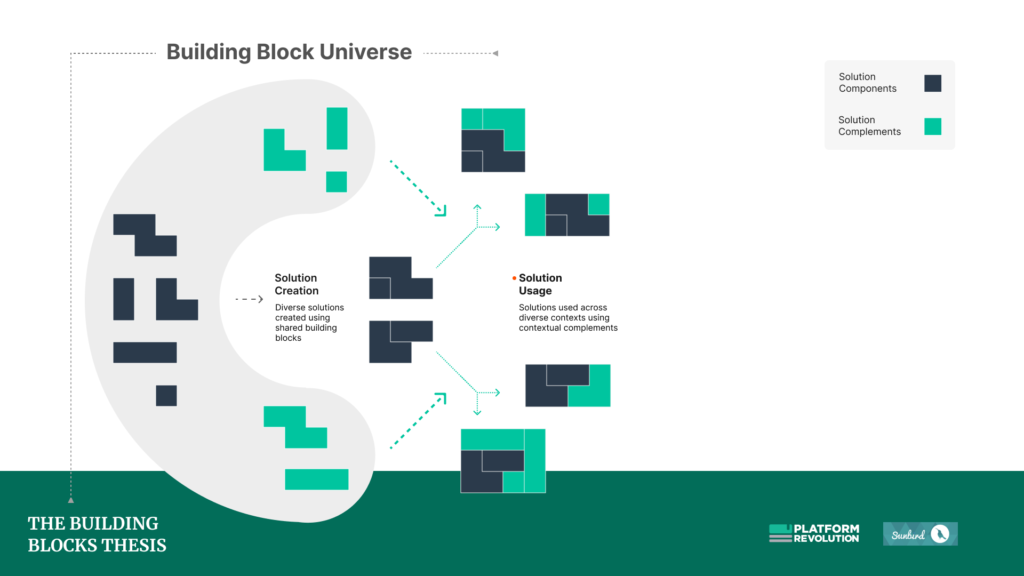
We call this a building blocks approach.
Let’s illustrate this with an example.
Solutions are often consumed as bundles of value. For instance, a primary school student consumes education as a bundle comprising textbooks, teacher-delivered training, self-administered testing etc.
A building blocks approach unbundles a solution bundle into its fundamental constituents – in the above example, textbooks, teacher-delivered training, self-administered testing etc. would serve as individual building blocks. Building blocks may be combined and recombined to create a wide scope of end solutions, each solution leveraging common building blocks.
For example, in the illustration above, self-administered testing is a component used to enable measuring progress as part of the overall education experience for the learner. However, self-administered testing itself leverages underlying building blocks (components), including curriculum, academic concepts, question banks, test creation logic, and certification logic.
A self-administered testing component can then be used with a large number of education programs as solution complements. In this manner, a building block approach helps us to unbundle and rebundle elements of value creation (a tetris-like approach to business modelling), allowing solutioning of complex problems.
Like Tetris, but for business model innovation
The building blocks approach focuses on leveraging the ecosystem towards
- creating standardized and reusable solution components (production building blocks) and
- creating a diverse range of solution complements (consumption building blocks) that enhance the value of solutions.
This approach focuses on standardizing the building blocks of a solution (e.g. standardized building blocks in education like question banks, test creation logic, and certification logic etc.) allowing new solutions to be created through a combination of building blocks.
Digital building blocks are standardized and modular units of value creation which, when combined, drive exponential value creation in an ecosystem.
We see the power of physical building blocks in the workings of construction and automotive assembly, where standardized building blocks (e.g. automotive components) – combined with standards and specifications guiding their assembly – enable the creation of a wide spectrum of end solutions. We advocate a similar approach with digital building blocks, which are not just standardized and modular but can also be cross-leveraged and reused (owing to zero costs of replication of digital components) across a wide range of contexts to generate new solutions.
Consider the GPS as an example of a digital building block that has driven massive value creation. Digital building blocks are:
- Autonomous: GPS provides location coordinates autonomously.
- Generic: GPS powers a wide range of solutions like maps, taxi aggregators, even fraud detection.
- Interoperable: GPS-powered services can be embedded into other solutions. A GPS kit can be fitted into a nationwide fleet of delivery trucks.
- Evolvable: E.g. Location data can be constantly improved, improving the utility of all solutions using it.
Digital building blocks are autonomous and hence perform specific tasks and functions independently. But by defining standards and specifications, these building blocks may be recombined towards solution design allowing interoperability between building blocks as well as interoperability between higher end solutions designed using these building blocks.
Standards and specifications enable autonomous building blocks to interoperate and coordinate across larger solution systems. As a result, digital building blocks enable solution design at ecosystem scale and diversity. A digital building block leverages digital technologies, enabling greater flexibility in solution design.
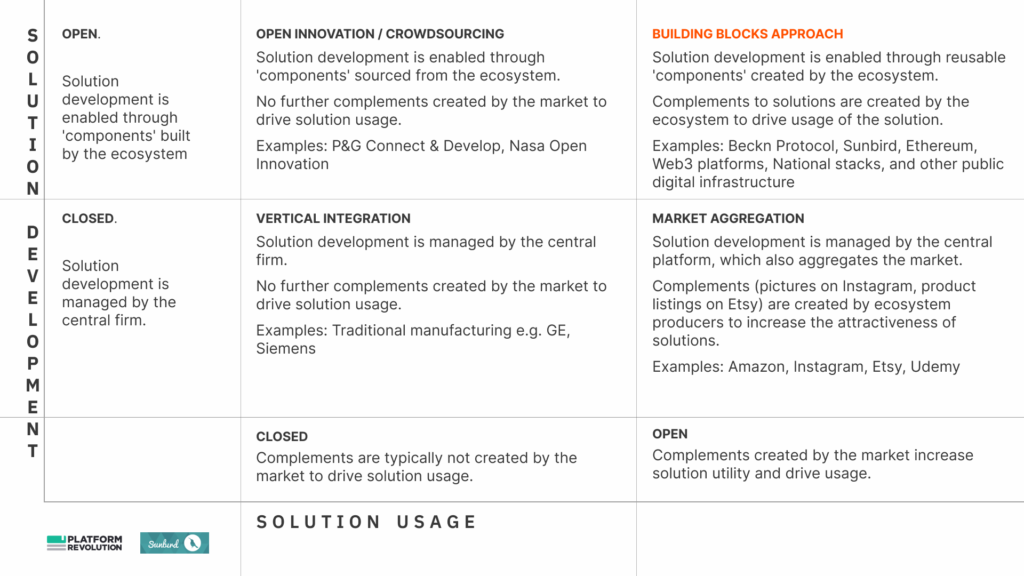
Effectively, digital building blocks enable a ‘system of solutions’ that are interoperable and can plug-and-play across each other, enabling a vast and seemingly unconnected ecosystem of solution creators to more effectively coordinate their efforts towards solving large-scale problems through diverse context-rich solutions.
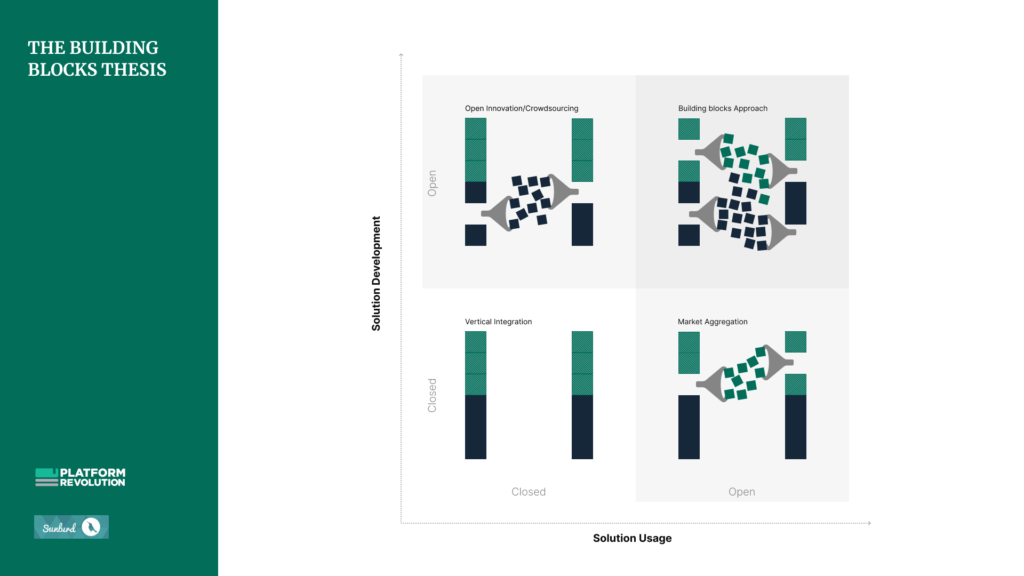
We’ve seen this before… but this time it’s different. And bigger!
We’ve seen the power of building blocks in the transformation of the financial services industry through the rise of financial derivatives and securitization. Financial services are informational building blocks and are easily modularized. Managing a portfolio of securities involves several value drivers – asset selection, trade execution, records and ownership management, ownership transfer, custody services etc – which can all be managed as modular building blocks. These building blocks have driven a high degree of innovation in the financial derivatives industry over the past three decades. Securities can be unbundled and rebundled into derivative financial products. Recombination of generic financial securities into derivative financial products focused on different risk profiles has enabled today’s landscape of global finance.
We believe that with the rise of digital building blocks, any industry can benefit from such innovation. In fact, digital building blocks enable further flexibility in unbundling and rebundling, allowing even higher innovation and solution development.
Case study: A building blocks approach to primary education
Consider the large-scale problem of delivering effective primary learning experiences, where the context of each child is divergent and, hence, not effectively solved through a one-size-fits-all solution. By leveraging standards and specifications, digital building blocks provide the benefits of context-specific solutions (through solution design) without sacrificing scale or agency (by enabling a ‘system of solutions’).
As an example, the EkStep Foundation created Sunbird as an integrated suite of open sourced, free to use building blocks. These building blocks are for learning, assessment, credentialing, registries, crowdsourced digital content creation, AI based language translation, AI based physical to digital data digitization.
In less than four years, Sunbird building blocks are now being used by Governments, non profits and market players across various sectors to create their own solutions – e.g. in school education platforms to serve hundreds of millions of children and for the training of millions of teachers, in health platforms to issue digitally verifiable credentials for over a billion vaccinations, to translate court orders in the judiciary, for continuous professional development of technology professionals. This allows distributed ‘solution stack’ building and usage across sectors. Value, agency, power, governance and risks are distributed, not concentrated.
Bringing it all together…
While the construction, automotive, and financial services industries have leveraged a physical building blocks approach to scale solution design, we are now in the early stages of employment of a digital building blocks approach in a variety of industries.
The rise of Web3 ecosystems increasingly shows the shift to a modular building blocks approach in value creation. The recent launch of the ONDC (Open Network for Digital Commerce) in India, as well as the rise of diverse Ethereum-based projects, demonstrates the developer traction that a digital building blocks approach will increasingly attract.
Digital building blocks are powerful agents of solutioning because:
- Like physical building blocks, they are standardized and modular can can be recombined to create new solutions (think Lego or Tetris)
- They are reusable owing to near-zero costs of replication, transcending the limitations of physical building blocks
- Standards and specifications enable autonomous building blocks to interoperate and coordinate across larger solution systems.
- Effectively, digital building blocks enable a ‘system of solutions’ that are interoperable and can plug-and-play across each other.
That, in summary, is the foundation of the building blocks thesis.

The Building Blocks Thesis – Deep-Dive
This is the first in a three-part volume titled The Building Blocks Thesis.
Sign up here to get early access to the Deep-Dive, launching on May 24, 2022
This series is co-authored with Shankar Maruwada, CEO and co-founder of the EkStep Foundation.
I am an advisor to the EkStep Foundation.
State of the Platform Revolution
The State of the Platform Revolution report covers the key themes in the platform economy in the aftermath of the Covid-19 pandemic.
This annual report, based on Sangeet’s international best-selling book Platform Revolution, highlights the key themes shaping the future of value creation and power structures in the platform economy.
Themes covered in this report have been presented at multiple Fortune 500 board meetings, C-level conclaves, international summits, and policy roundtables.
Subscribe to Our Newsletter



